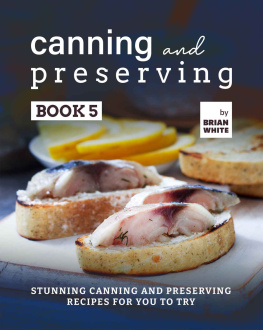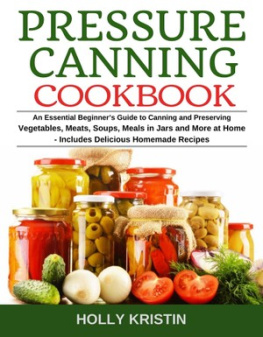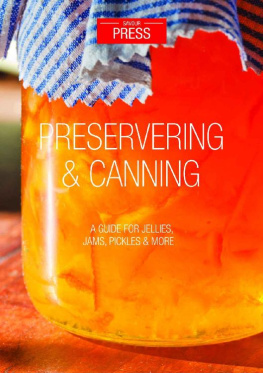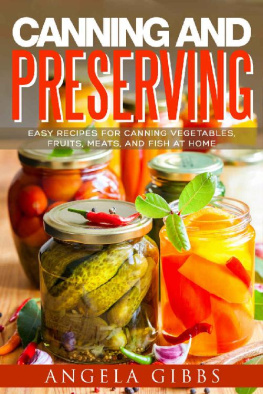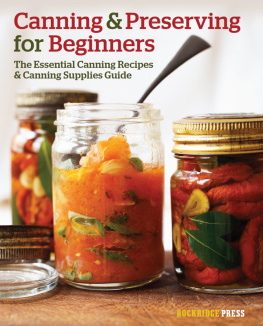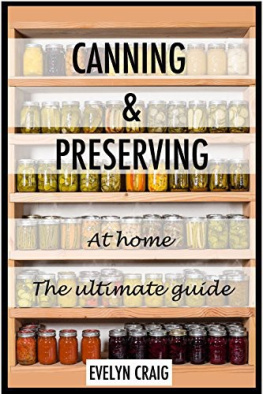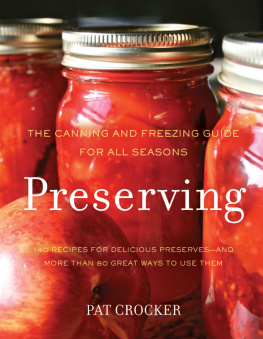THE FRESH GIRLS GUIDE TO
Easy Canning
and Preserving
by Ana Micka

Contents
Getting Started

A Note from the Author...
Do you want to eat locally grown food, support family farmers, and save money on food? Heres how: learn to can!
I taught myself to can ten years ago in order to use locally grown food and reduce additives in my familys diet. I started with the basics: jam and stewed tomatoes. Ive now expanded my repertoire to include recipes and flavors from around the globe.
I also quickly learned how to use a pressure canner, my favorite kitchen tool. I recouped the cost in one canning season. With the pressure canner, I can make the most of fresh, in-season vegetables from the garden and market. Best of all, the pressure canner allows me to can meals in a jar, including soups, chili, and even pulled pork. During the busy school year, its a great relief and joy to open the cupboard and have dinner on hand.
The Fresh Girls Guide to Easy Canning and Preserving gives you all the information you need to start canning today. Ill show you the basic steps to home canning and provide four simple rules for safely canning foods.
In my own kitchen I focus on healthy foods, so I asked expert canner Paula Pentel to share her Minnesota State Fair award-winning applesauce recipe and her personal recipe for low-sugar strawberry jam. Yum!
So peruse the recipes in this book and enjoy the best of what the harvest has to offer.
Ana

Home Cannings 15 Minutes of Fame
Home canning was a badge of patriotism during World War II. Major public relations campaigns encouraged Americans to plant Victory Gardens and can their own food to keep fruits and vegetables affordable during the war. According to Rose Hayden-Smith, a leading victory garden historian and director of the University of California Cooperative Extension in Ventura County, more than twenty million gardens were planted in backyards and vacant lots during World War II. These gardens produced up to forty percent of all the vegetable produce consumed nationally!
Canning is regaining popularity today for many reasons.
2,000 Miles Closer to Home
Home canning is a great way to reduce your carbon footprint. Produce in the United States typically travels 1,300 to 2,000 miles (about 2,000 to 3,200 km) from farm to table. Eighty percent of the energy used in the food sector goes toward processing, transportation, and storage.
Dollars spent to buy produce directly from farmers create a stronger local economy. Plus fresh, local food just tastes better.
Good Food at Affordable Prices
Home canning is a sure way to avoid corn syrup, industrial oils, additives, and high levels of sodium. My daughter is on a gluten-free diet and canning gives me confidence in the foods I prepare for her.
Of course, canning is also a sure way to eat locally grown food year-round without blowing your budget. Produce is abundant and very affordable when its in season. A quart of filling squash soup can cost you only seventy-five cents to prepare, and spaghetti sauce can be as low as a dollar per jar. Ill give you suggestions for finding great produce and some tips on how to grow your own.

Growing a Canning Garden
If you have a sunny space in your yard or are lucky enough to have access to a community garden, prepare the soil and grow your own canning garden using these tips and guides.
Tomatoes
Tomatoes are by far the most popular garden plant. The best varieties for canning are the Roma (plum) tomatoes. These smaller, oval tomatoes have more meat, fewer seeds, and pack a lot of rich tomato flavor into your jars. Romas are also determinate tomatoes, meaning they tend to ripen at or near the same time. This can be a benefit when youre harvesting for the purpose of canning. Other tomatoes such as Celebrity, Brandywine, and similar hybrid and heirloom varieties also work well.
Tomato planting guidelines:
Youll need about 3 pounds (1.4 kg) of tomatoes for each quart (about a liter) of canned tomatoes. For a canner batch of 7 quarts (6.6 l), plan on planting the following quantities of tomato plants:
* Roma tomato plants: Plant 3-4 plants for a 7-quart (6.6 l) canning recipe. Each plant yields 6-8 pounds (2.7-3.6 kg) of fruit on average.
* Celebrity/Brandywine tomato plants: Plant 2-3 plants for 7 quarts (6.6 l). Each plant yields 8-12 pounds (3.6-5.4 kg) of fruit on average.
Plant your tomatoes 18-36 inches (45.8-91.4 cm) apart in soil prepared with compost. Tomatoes require a lot of nutrients, so I recommend adding 5-6 pounds (2.3-2.7 kg) of compost for every square foot (30.5 square centimeters) of garden space. Tomatoes also need sun, so plant them where they will receive 7 hours of sunlight each day. Water, mulch, and stake your plants, and in 2 or 3 months youll be harvesting!
The smaller tomato varieties can be planted in containers. This can be a good option for Roma tomato plants if you have limited growing .
Vegetables
Beans, beets, carrots, corn, cucumbers, potatoes, and squash round out your canning garden. Plant plentyif you have room!
Get creative with your space. Increase your harvest by growing beans and squash vertically and make use of containers. See tips for growing container gardens on .
Plan for succession planting. In most climates, you will be able to plant several crops of beans and possibly even beets and carrots. A fall crop of beans, for example, can be planted in garden spaces emptied by mid-season harvesting.
If you need space, find and join a community garden in your area.
The website www.communitygarden.org lists many gardens across the country. Also call your city, township, or local neighborhood association, as many gardens are not listed.
Friends and neighbors who have larger yards may also be open to a sharing arrangement.
Fruits
If you have enough space and plan to stay for a while, planting fruit trees, bushes, and plants is very rewarding. They are often beautiful additions to your yard and can provide significant cost savings.
Look into edible landscaping and permaculture gardening for ways to introduce fruits throughout your yard. Dwarf apple bushes, blueberry bushes, and strawberries can easily be incorporated into eye-pleasing landscapes, even in front yards!
Only have space for a small garden?
Grow a salsa garden:
For 7 pints (3.3 l) of salsa, plant:
1-2 tomato plants
1 green pepper plant
1 jalapeno pepper plant
1 banana pepper plant
1 cilantro plant

Planting in Containers
Container gardening can be a great way to expand your garden harvest. You can grow smaller varieties of tomatoes and common canning vegetables like cucumbers, beans, and peppers. Here are a few tips for a successful growing season:


